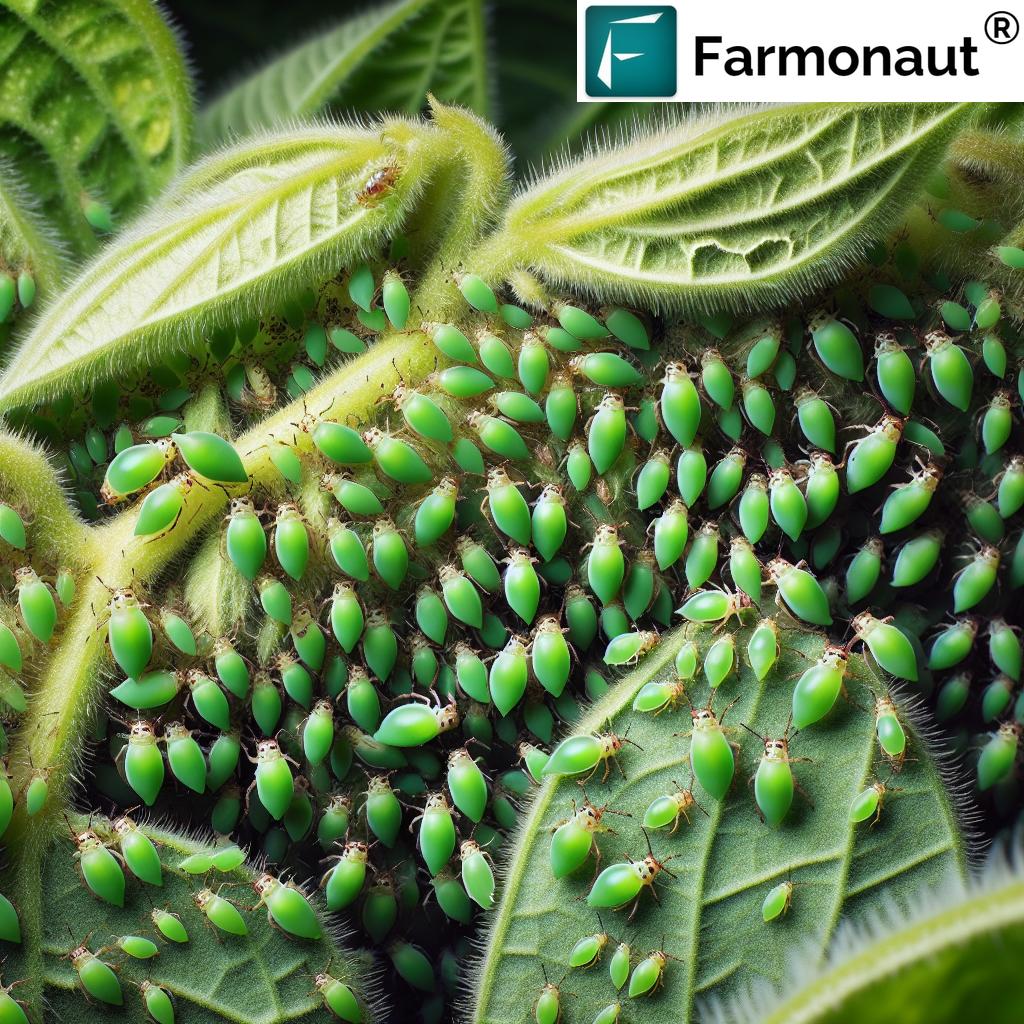Mastering Soybean Aphid Management: Effective Scouting and Control Strategies for Optimal Crop Yield

As agricultural technology experts at Farmonaut, we understand the critical importance of managing soybean aphids effectively to ensure optimal crop yields. In this comprehensive guide, we’ll explore the intricate world of soybean aphid management, from identifying these pests to implementing cutting-edge control strategies. Our goal is to equip farmers and agricultural professionals with the knowledge and tools necessary to protect their soybean crops and maximize their productivity.
Understanding Soybean Aphids: A Microscopic Menace
Soybean aphids (Aphis glycines) are tiny, pear-shaped insects that pose a significant threat to soybean crops worldwide. These minuscule pests, measuring only about 1/16 inch long, can rapidly reproduce and cause extensive damage if left unchecked. Let’s delve into the characteristics and lifecycle of these agricultural adversaries.
Identifying Soybean Aphids
Soybean aphids are easily recognizable by their distinctive features:
- Pale yellow to light green color
- Pear-shaped body
- Black cornicles (tube-like structures) on the rear end
- Winged and wingless forms
These insects primarily feed on the sap of soybean plants, clustering on stems, leaves, and pods. As they extract nutrients from the plant, they can cause significant stress and damage to the crop.
Lifecycle and Reproduction
Understanding the lifecycle of soybean aphids is crucial for effective management. These pests can produce multiple generations within a single growing season, leading to rapid population growth.
- Overwintering: Aphids survive winter as eggs on buckthorn plants.
- Spring emergence: Nymphs hatch and develop into wingless females.
- Migration to soybeans: Winged aphids fly to soybean fields in late spring or early summer.
- Rapid reproduction: Females give birth to live young, which can begin reproducing in as little as 7 days.
- Multiple generations: Up to 15-18 generations can occur in a single growing season.
- Fall migration: Aphids return to buckthorn plants to lay overwintering eggs.
This rapid reproductive cycle allows soybean aphid populations to explode quickly, making early detection and management crucial.
The Impact of Soybean Aphids on Crop Health and Yield
Soybean aphids can have a devastating impact on soybean crops, leading to significant yield losses if not properly managed. Let’s examine the various ways these pests affect plant health and productivity.
Direct Damage from Feeding
As aphids feed on the sap of soybean plants, they cause several issues:
- Stunted growth and reduced plant vigor
- Yellowing and distortion of leaves
- Reduced pod formation and seed size
- Decreased photosynthetic capacity
In severe infestations, entire plants may become covered in aphids, leading to wilting and potentially plant death.
Indirect Damage: Viral Diseases and Honeydew
Beyond direct feeding damage, soybean aphids can cause additional problems:
- Viral disease transmission: Aphids can spread various viral diseases, such as Soybean Mosaic Virus (SMV) and Alfalfa Mosaic Virus (AMV).
- Honeydew production: As aphids feed, they excrete a sticky substance called honeydew, which can promote the growth of sooty mold on leaves, further reducing photosynthesis.
Economic Impact on Soybean Production
The combined effects of soybean aphid infestations can lead to significant economic losses for farmers:
- Yield reductions of up to 40% in severe cases
- Increased production costs due to the need for pest control measures
- Potential quality issues in harvested soybeans
Given these potential losses, implementing effective soybean aphid management strategies is crucial for maintaining profitable soybean production.
Scouting for Soybean Aphids: The Foundation of Effective Management

At Farmonaut, we emphasize the importance of regular and thorough scouting as the cornerstone of successful soybean aphid management. Effective scouting allows farmers to detect infestations early, make informed decisions about control measures, and minimize crop damage. Let’s explore the key aspects of soybean aphid scouting.
When to Begin Scouting
Scouting for soybean aphids should begin early in the growing season and continue regularly throughout:
- Start scouting when soybeans reach the V1 (first trifoliate) stage
- Increase frequency during periods of rapid vegetative growth
- Continue scouting through the R6 (full seed) stage
Systematic Scouting Methods
To ensure thorough coverage of your soybean fields, employ systematic scouting methods:
- Field pattern: Walk a W or Z pattern through the field to sample plants from various areas.
- Plant selection: Randomly select plants at each sampling point.
- Sample size: Examine at least 20-30 plants per field, or more for larger fields.
- Plant inspection: Check the undersides of leaves, stems, and growing points for aphids.
- Count and record: Estimate the number of aphids per plant and record your observations.
What to Look For During Scouting
When scouting for soybean aphids, pay attention to the following:
- Presence of aphids on leaves, stems, and pods
- Signs of plant stress or damage (e.g., yellowing, stunting)
- Presence of natural enemies (e.g., lady beetles, lacewings)
- Evidence of honeydew or sooty mold
- Overall plant health and growth stage
Scouting Tools and Technology
While traditional scouting methods remain valuable, new technologies are enhancing the efficiency and accuracy of aphid detection:
- Handheld magnifiers for close inspection of plants
- Smartphone apps for recording and tracking observations
- Drone-based imaging for large-scale field assessment
- Satellite-based monitoring systems, like those offered by Farmonaut, for comprehensive field analysis
By leveraging these tools, farmers can improve their ability to detect and respond to soybean aphid infestations promptly.
Comparing Traditional Scouting with Farmonaut’s Satellite-Based Detection
| Method | Time Efficiency | Coverage Area | Early Detection Capability | Cost-Effectiveness |
|---|---|---|---|---|
| Traditional Manual Scouting | Time-consuming, requires frequent field visits | Limited to areas physically scouted | Moderate, depends on scouting frequency | Labor-intensive, higher cost for large areas |
| Farmonaut’s Satellite-Based System | Highly efficient, real-time monitoring | Comprehensive coverage of entire fields | High, can detect stress indicators before visible symptoms | Cost-effective, especially for large-scale operations |
As this comparison illustrates, Farmonaut’s satellite-based soybean aphid detection system offers significant advantages in terms of efficiency, coverage, and early detection capabilities. By integrating these advanced technologies with traditional scouting methods, farmers can dramatically improve their aphid management strategies.
Economic Thresholds and Decision-Making
Understanding economic thresholds is crucial for making informed decisions about when to implement control measures for soybean aphids. These thresholds help balance the cost of treatment against potential yield losses.
Defining Economic Thresholds
The economic threshold for soybean aphids is typically set at 250 aphids per plant, with 80% of the plants infested. However, this threshold may vary based on factors such as:
- Soybean growth stage
- Market prices for soybeans
- Cost of control measures
- Environmental conditions
Factors Influencing Treatment Decisions
When deciding whether to treat for soybean aphids, consider the following:
- Aphid population density and distribution
- Rate of population growth
- Presence of natural enemies
- Plant growth stage and overall health
- Weather forecasts (e.g., temperature, rainfall)
- Proximity to harvest
By carefully weighing these factors against economic thresholds, farmers can make more informed decisions about aphid management.
Integrated Pest Management Strategies for Soybean Aphids
At Farmonaut, we advocate for an Integrated Pest Management (IPM) approach to controlling soybean aphids. This comprehensive strategy combines various methods to effectively manage pest populations while minimizing environmental impact and preserving beneficial insects.
Cultural Control Methods
Cultural control practices focus on creating an environment less favorable for aphid development:
- Crop rotation: Alternating soybeans with non-host crops can disrupt aphid life cycles.
- Planting date adjustments: Early or late planting may help avoid peak aphid populations.
- Resistant varieties: Choosing soybean varieties with aphid resistance can reduce infestation severity.
- Field sanitation: Removing alternate hosts like buckthorn can limit overwintering sites.
Biological Control
Biological control leverages natural enemies of soybean aphids to keep populations in check:
- Predators: Lady beetles, lacewings, and predatory flies
- Parasitoids: Tiny wasps that lay eggs inside aphids
- Pathogens: Naturally occurring fungi that infect and kill aphids
Encouraging these beneficial organisms can provide long-term, sustainable aphid control.
Chemical Control
When aphid populations exceed economic thresholds, chemical control may be necessary:
- Insecticide selection: Choose products effective against aphids while minimizing impact on beneficial insects.
- Timing of application: Apply insecticides when aphid populations reach economic thresholds.
- Resistance management: Rotate insecticide classes to prevent resistance development.
Always follow label instructions and local regulations when applying insecticides.
Host Plant Resistance
Planting soybean varieties with built-in resistance to aphids can be an effective long-term strategy:
- Rag1 and Rag2 genes provide resistance to certain aphid biotypes
- Resistant varieties may slow aphid population growth and reduce the need for chemical control
- Consider regional aphid biotypes when selecting resistant varieties
Advanced Technologies in Soybean Aphid Management
At Farmonaut, we’re at the forefront of integrating cutting-edge technologies into soybean aphid management. These innovations are revolutionizing the way farmers monitor and control aphid populations.
Satellite-Based Crop Monitoring
Our satellite-based crop monitoring system offers several advantages for soybean aphid management:
- Early detection of plant stress indicators that may signal aphid infestations
- Comprehensive field coverage, allowing for targeted scouting and treatment
- Historical data analysis to identify patterns and high-risk areas
- Integration with weather data for more accurate prediction of aphid outbreaks
To learn more about our satellite monitoring capabilities, visit Farmonaut’s Crop Monitoring Platform.
AI-Powered Pest Identification
Artificial Intelligence (AI) is enhancing our ability to identify and quantify soybean aphid populations:
- Image recognition algorithms for rapid aphid identification
- Automated counting of aphids per plant for more accurate population estimates
- Machine learning models to predict population growth and spread
Precision Agriculture Applications
Precision agriculture techniques are improving the efficiency of aphid management:
- Variable rate technology for targeted insecticide applications
- GPS-guided scouting to ensure thorough field coverage
- Drone-based imaging for high-resolution field mapping
Mobile Apps and Decision Support Tools
Farmonaut offers mobile applications to assist farmers in soybean aphid management:
- Real-time field monitoring and alerts
- Scouting data collection and analysis
- Treatment recommendation engines based on economic thresholds
Download our mobile app for iOS here or for Android here.
Best Practices for Sustainable Soybean Aphid Management
Implementing sustainable practices in soybean aphid management is crucial for long-term crop health and environmental stewardship. Here are some best practices we recommend:
Regular Monitoring and Scouting
- Conduct weekly scouting throughout the growing season
- Use a combination of manual scouting and technology-assisted monitoring
- Keep detailed records of aphid populations and distribution
Preserving Beneficial Insects
- Avoid broad-spectrum insecticides when possible
- Create habitat for natural enemies (e.g., flower strips, cover crops)
- Consider economic thresholds that account for natural enemy populations
Implementing Resistance Management
- Rotate insecticide classes to prevent resistance development
- Use resistant soybean varieties as part of an integrated approach
- Monitor for changes in aphid response to control measures
Optimizing Nutrient Management
- Maintain balanced soil fertility to promote plant health
- Avoid excessive nitrogen applications, which can favor aphid development
- Use soil testing and precision agriculture techniques for optimal nutrient management
Collaboration and Knowledge Sharing
- Participate in local farming networks and extension programs
- Share experiences and best practices with other soybean growers
- Stay informed about the latest research and management techniques
The Future of Soybean Aphid Management
As we look to the future, several emerging trends and technologies promise to further revolutionize soybean aphid management:
Gene Editing and Advanced Breeding
- Development of new soybean varieties with enhanced aphid resistance
- Potential for CRISPR technology to create more resilient crops
- Exploration of novel traits that deter aphid feeding or reproduction
Predictive Modeling and Big Data Analytics
- Advanced algorithms to predict aphid outbreaks based on environmental factors
- Integration of regional data for more accurate forecasting
- Machine learning models that improve over time with accumulated data
Nanotechnology in Pest Control
- Development of nano-scale pesticides for more targeted and efficient control
- Nanoparticle-based sensors for early detection of aphid infestations
- Nano-enhanced plant protection products with reduced environmental impact
Integrated Pest Management 2.0
- Holistic approaches that consider entire agroecosystems
- Greater emphasis on preventive strategies and biological control
- Increased use of automation and AI in decision-making processes
Conclusion: Empowering Farmers for Successful Soybean Aphid Management
Effective soybean aphid management requires a multifaceted approach that combines traditional farming wisdom with cutting-edge technology. At Farmonaut, we’re committed to providing farmers with the tools and knowledge they need to protect their soybean crops and maximize yields.
By integrating regular scouting, economic threshold-based decision-making, and advanced monitoring technologies, farmers can stay ahead of soybean aphid infestations. Our satellite-based crop monitoring system, coupled with AI-powered analytics, offers unprecedented insights into field conditions, enabling more timely and targeted interventions.
As we continue to innovate and develop new solutions, we remain focused on sustainable practices that balance pest control with environmental stewardship. The future of soybean aphid management is bright, with emerging technologies promising even greater precision and efficiency in pest control.
We encourage soybean growers to take advantage of the resources and technologies available through Farmonaut. Together, we can build a more resilient and productive agricultural future.
FAQ: Soybean Aphid Management
Q: How often should I scout for soybean aphids?
A: We recommend scouting weekly throughout the growing season, starting at the V1 stage and continuing through R6.
Q: What is the economic threshold for treating soybean aphids?
A: The general economic threshold is 250 aphids per plant, with 80% of plants infested. However, this may vary based on factors like soybean prices and growth stage.
Q: Can I rely solely on resistant soybean varieties for aphid control?
A: While resistant varieties are valuable, they should be part of an integrated pest management approach that includes other control methods.
Q: How can Farmonaut’s satellite monitoring help with aphid management?
A: Our satellite monitoring system can detect early signs of plant stress, allowing for targeted scouting and timely interventions before aphid populations reach damaging levels.
Q: Are there any natural enemies of soybean aphids I should be aware of?
A: Yes, lady beetles, lacewings, and parasitic wasps are important natural enemies of soybean aphids. Preserving these beneficial insects can help control aphid populations naturally.
Q: How can I access Farmonaut’s crop monitoring services?
A: You can sign up for our services through our website or mobile app. Visit Farmonaut’s Platform to get started.













